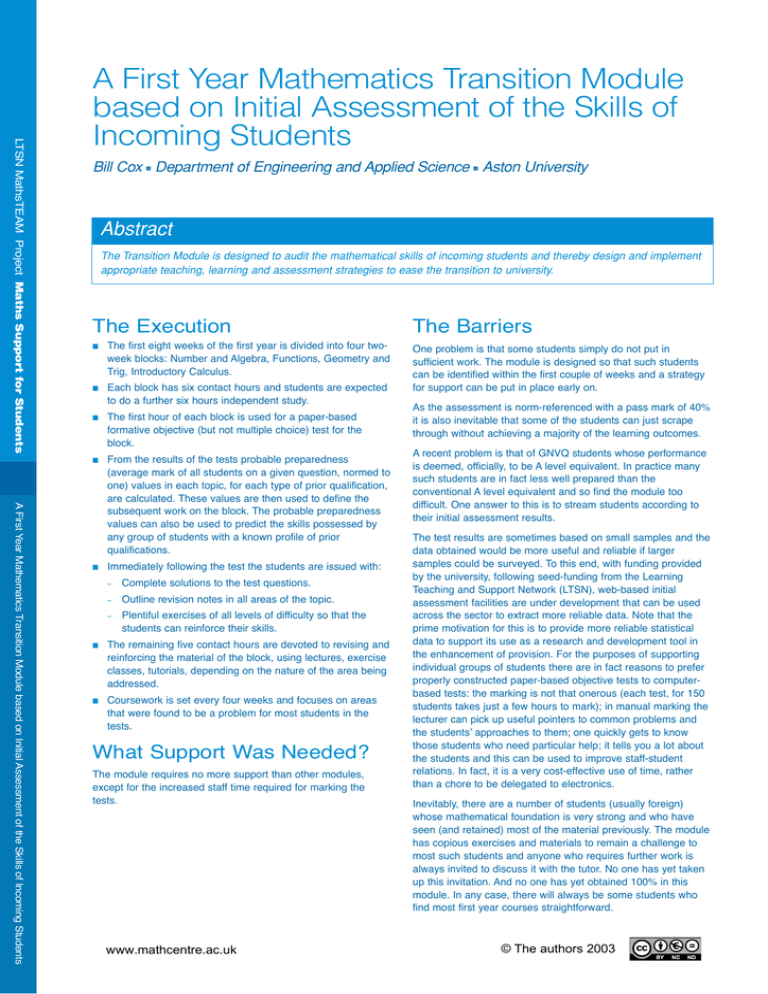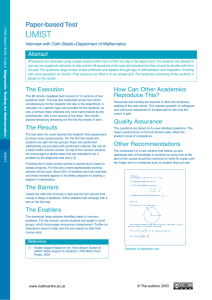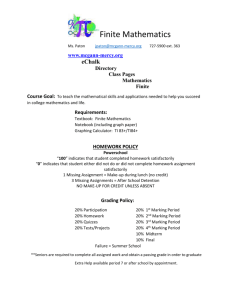Abstract
advertisement

LTSN MathsTEAM Project Maths Support for Students A First Year Mathematics Transition Module based on Initial Assessment of the Skills of Incoming Students Bill Cox ■ Department of Engineering and Applied Science ■ Aston University Abstract The Transition Module is designed to audit the mathematical skills of incoming students and thereby design and implement appropriate teaching, learning and assessment strategies to ease the transition to university. The Execution A First Year Mathematics Transition Module based on Initial Assessment of the Skills of Incoming Students ■ The first eight weeks of the first year is divided into four twoweek blocks: Number and Algebra, Functions, Geometry and Trig, Introductory Calculus. ■ Each block has six contact hours and students are expected to do a further six hours independent study. ■ The first hour of each block is used for a paper-based formative objective (but not multiple choice) test for the block. ■ From the results of the tests probable preparedness (average mark of all students on a given question, normed to one) values in each topic, for each type of prior qualification, are calculated. These values are then used to define the subsequent work on the block. The probable preparedness values can also be used to predict the skills possessed by any group of students with a known profile of prior qualifications. ■ Immediately following the test the students are issued with: – Complete solutions to the test questions. – Outline revision notes in all areas of the topic. – Plentiful exercises of all levels of difficulty so that the students can reinforce their skills. ■ The remaining five contact hours are devoted to revising and reinforcing the material of the block, using lectures, exercise classes, tutorials, depending on the nature of the area being addressed. ■ Coursework is set every four weeks and focuses on areas that were found to be a problem for most students in the tests. What Support Was Needed? The module requires no more support than other modules, except for the increased staff time required for marking the tests. www.mathcentre.ac.uk The Barriers One problem is that some students simply do not put in sufficient work. The module is designed so that such students can be identified within the first couple of weeks and a strategy for support can be put in place early on. As the assessment is norm-referenced with a pass mark of 40% it is also inevitable that some of the students can just scrape through without achieving a majority of the learning outcomes. A recent problem is that of GNVQ students whose performance is deemed, officially, to be A level equivalent. In practice many such students are in fact less well prepared than the conventional A level equivalent and so find the module too difficult. One answer to this is to stream students according to their initial assessment results. The test results are sometimes based on small samples and the data obtained would be more useful and reliable if larger samples could be surveyed. To this end, with funding provided by the university, following seed-funding from the Learning Teaching and Support Network (LTSN), web-based initial assessment facilities are under development that can be used across the sector to extract more reliable data. Note that the prime motivation for this is to provide more reliable statistical data to support its use as a research and development tool in the enhancement of provision. For the purposes of supporting individual groups of students there are in fact reasons to prefer properly constructed paper-based objective tests to computerbased tests: the marking is not that onerous (each test, for 150 students takes just a few hours to mark); in manual marking the lecturer can pick up useful pointers to common problems and the students’ approaches to them; one quickly gets to know those students who need particular help; it tells you a lot about the students and this can be used to improve staff-student relations. In fact, it is a very cost-effective use of time, rather than a chore to be delegated to electronics. Inevitably, there are a number of students (usually foreign) whose mathematical foundation is very strong and who have seen (and retained) most of the material previously. The module has copious exercises and materials to remain a challenge to most such students and anyone who requires further work is always invited to discuss it with the tutor. No one has yet taken up this invitation. And no one has yet obtained 100% in this module. In any case, there will always be some students who find most first year courses straightforward. © The authors 2003 The Transition Module is a School of Engineering and Applied Science module, compulsory for all first year engineering and mathematics students. Because of the special nature of its aims it is generously supported. The Transition Module is subject to the same quality procedures as all modules and fares well in that respect. Since it services a large proportion of the first year students in the School there is a wide range of feedback from staff and students. Evidence of Success Other Recommendations In the first few years of presentation the Transition Module dramatically increased pass rates and continues to return respectable pass rates in mathematics and service courses compared to other modules. Because of the detailed initial assessment it is possible to use the examination results to provide a direct measure of added-value in the performance of the students and this has always been substantial. The probable preparedness data obtained in the course of this module, examples of which are given on the website reference, can be used for a variety of purposes, in addition to supporting the module. Some such applications are given on the website and further references included there. In particular, it provides a crude picture of the extent to which entrants retain and can use the skills acquired in their prior education. This is of relevance to the wider debate with schools and FE colleges relating to problem areas in the mathematical knowledge of first year undergraduates. The Transition Module always receives positive feedback from students and was commended by the Subject Reviews in MSOR and in civil engineering and by various engineering accreditations. How Can Other Academics Reproduce This? Many providers already use ‘diagnostic tests’ to ease the transition to university, some linked to information technology, but may still find some useful ideas in this case study. The probable preparedness data may help them in realistic design of their curriculum and in informing expectations of their staff. Also, it is helpful if the institution can be persuaded that the time that needs to be allocated is necessary and worthwhile for a smooth transition to university. www.mathcentre.ac.uk Reference School/University Interface – What can Students Do? What Maths Skills do Incoming Students Have?; http://ltsn.mathstore.ac.uk/workshops/ maths-support/report.htm#1A; Cox, W.; (13-09-02). © The authors 2003 A First Year Mathematics Transition Module based on Initial Assessment of the Skills of Incoming Students Quality Assurance LTSN MathsTEAM Project Maths Support for Students The Enablers



